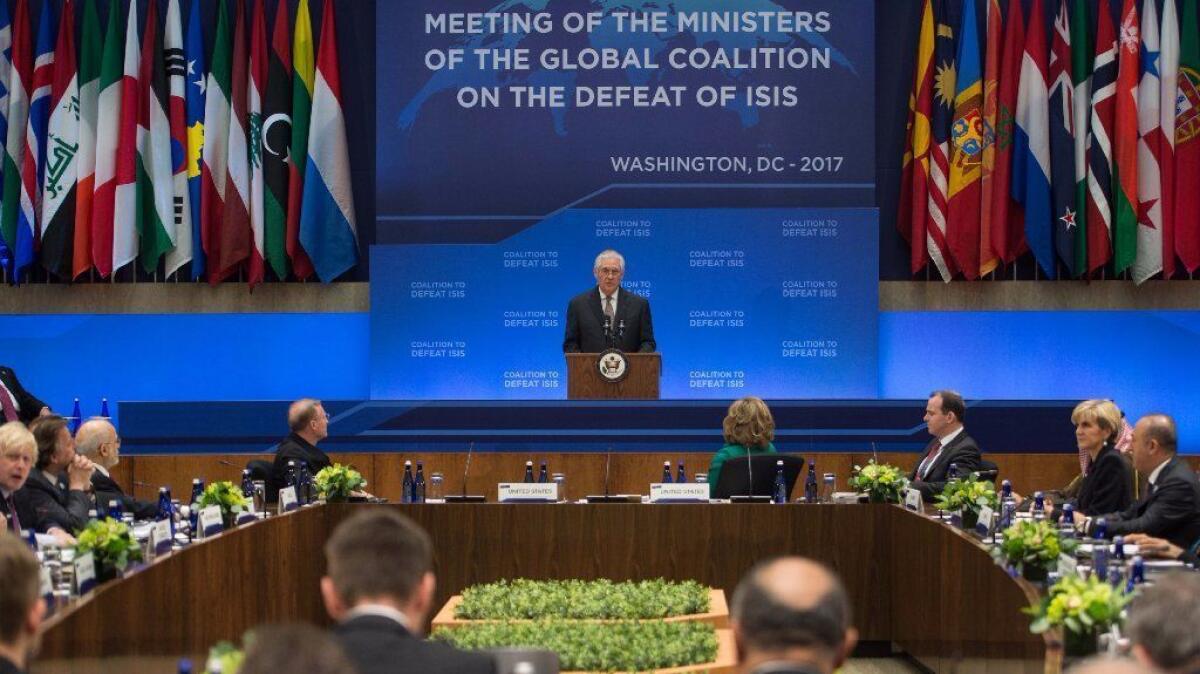Tillerson calls for more allied support in fight against Islamic State

- Share via
Reporting from Washington — As representatives from more than 60 nations gathered here to share strategies on defeating Islamic State, U.S. helicopters ferried hundreds of Syrian fighters into a battle Wednesday in southern Syria in a major new offensive.
During the night, U.S. helicopters carried nearly 500 Syrian fighters for the first time behind the militants’ defensive lines near the Tabqa Dam, about 25 miles west of Raqqah, the militants’ self-declared capital and a crucial stronghold, according to the Pentagon.
Marines fired artillery while Apache helicopters delivered airstrikes, and Special Forces advisors worked with Syrian commanders to direct the assault, which aimed to retake the dam and a nearby airfield, Pentagon officials said.
Col. Joseph Scrocca, a U.S. spokesman based in Baghdad, said in a teleconference with Pentagon reporters that the Americans supported the Syrian Democratic Forces, a coalition of Arab and Kurdish rebel groups that operates chiefly in northern Syria.
“Our advisors are advising,” he said. “They are not fighting on the front line.”
The operation is expected to take weeks, he said. Retaking the dam, under Islamic State control since 2013, is considered a critical step to cutting the militants’ supply lines and defensive positions around Raqqah.
The offensive came as foreign ministers and other delegations from 68 nations and international organizations in the U.S.-led coalition gathered at the State Department for their first full meeting since 2014.
Secretary of State Rex Tillerson said the Trump administration views defeating Islamic State as its “number one goal in the region.”
“Hard-fought victories in Syria and Iraq have swung the momentum in our coalition’s favor, but we must intensify our efforts and solidify our gains in the next phase of the counter-ISIS fight,” said Tillerson, using an acronym for Islamic State.
While his remarks were short on specifics, Tillerson offered a glimpse of a new U.S. strategy as the militants come under growing pressure.
Tillerson said the United States “will work to establish interim zones of stability, through cease-fires, to allow refugees to return home,” using language that suggests creation of no-fly zones to protect refugees in northern Syria.
The Obama administration resisted creating no-fly zones because it said doing so would tie up too many aircraft and other military resources. During the presidential campaign, both Donald Trump and his Democratic opponent, Hillary Clinton, said they favored creating such havens.
Tillerson did not say where, when or how safe havens would be created, or how they would operate. But there are patches along the Syrian border with Turkey where Turkish troops and others have enforced cease-fires.
Tillerson made clear he was not committing to an open-ended U.S. presence in Syria.
“As a coalition, we are not in the business of reconstruction or nation-building,” he said.
He urged the other nations to contribute more to prevent the resurgence of Islamic State, and to help rebuild Syria.
“Circumstances on the ground require more of all of you,” Tillerson said. He said the coalition had identified $2 billion in humanitarian needs, including infrastructure and de-mining, for the millions of people displaced in the fighting.
“We will continue to facilitate the return of people to their homes and work with local political leadership,” he said. “They will provide stable and fair governance, rebuild infrastructure and provide essential services.”
The Pentagon has about 5,200 troops in Iraq and 1,000 in Syria. They rely on local ground forces to carry out combat operations, while the U.S. and its allies provide intelligence, launch airstrikes and fire artillery to support the ground attacks.
Over the last year, the combined attacks have pushed the Sunni militants from most major cities in Iraq. Despite a five-month U.S.-backed assault, heavy fighting is still underway to retake the group’s remaining stronghold in Mosul, Iraq’s second-largest city.
The challenge is tougher in Syria, where a separate multi-sided civil war has drawn Russia and Iran as backers of President Bashar Assad’s government. The U.S. and its allies oppose Assad and try to focus on fighting Islamic State and its allies.
On Wednesday, humanitarian groups said at least 30 civilians were killed when an airstrike hit a school in Mansoura, south of Raqqah. The Syrian Observatory for Human Rights, a British-based monitoring group that relies on activists in Syria, said people had been using the facility for shelter.
For more on international affairs, follow @TracyKWilkinson on Twitter
william.hennigan@latimes.com
More to Read
Sign up for Essential California
The most important California stories and recommendations in your inbox every morning.
You may occasionally receive promotional content from the Los Angeles Times.












